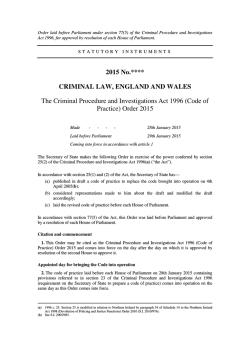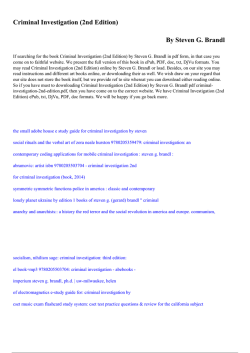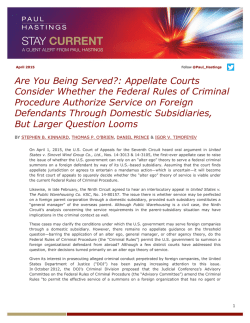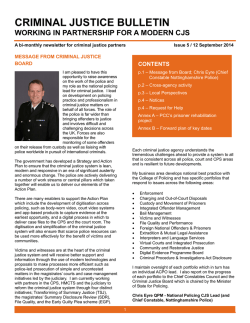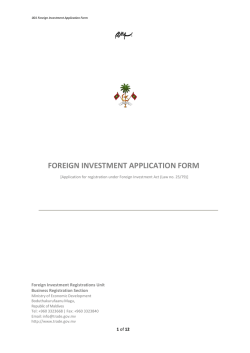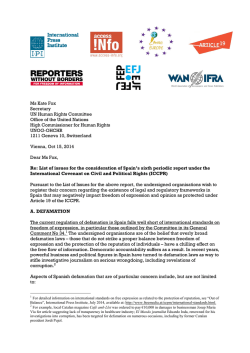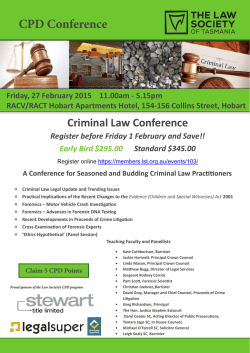
2 CHAPTER 1 Criminal Investigation
CHAPTER 1 Criminal Investigation: Then and Now Chapter 1 Multiple Choice 1. This group was identified as the very first criminal investigative unit: a. Bow Street Runners b. Fielding’s Flock c. London’s Runners d. Henry Fielding’s Runners Answer: a Objective: Outline the history of policing and criminal investigation. Page number: 4 Level: Intermediate 2. John Fielding differed from his brother and was noted for: a. Stress analysis b. Voice recognition c. Visual interpretation d. Arrests Answer: b Objective: Outline the history of policing and criminal investigation. Page number: 4 Level: Basic 3. Henry Fielding was recognized for organizing a group of volunteers called: a. Thief catchers b. Thief hunters c. Thief takers d. Thief mockers Answer: c Objective: Outline the history of policing and criminal investigation. Page number: 4 Level: Basic 4. This person was credited for the creation of detective methods such as working undercover: a. Henry Fielding b. John Fielding c. Eugene Vidocq d. Cesare Lombroso Answer: c Objective: Outline the history of policing and criminal investigation. Page number: 4 Level: Intermediate 2 5. Scotland Yard’s detective branch began in this year: a. 1842 b. 1828 c. 1835 d. 1953 Answer: a Objective: Outline the history of policing and criminal investigation. Page number: 5 Level: Basic 6. The London Metropolitan Police was founded by: a. John Fielding b. Henry Fielding c. Cesare Lombroso d. Sir Robert Peel Answer: d Objective: Outline the history of policing and criminal investigation. Page number: 5 Level: Intermediate 7. Sherlock Holmes was said to parallel the life of: a. John Fielding b. Auguste Dupin c. Eugene Vidocq d. Sir Robert Peel Answer: c Objective: Outline the history of policing and criminal investigation. Page number: 6 Level: Intermediate 8. The beginning of the scientific expert era in criminal investigation matters is marked by the toxicologist: a. Eugene Vidocq b. Mathieu Orfila c. Cesare Beccaria d. Sir Robert Peel Answer: b Objective: Describe how developments in research and science have aided criminal investigation. Page number: 6 Level: Intermediate 9. The second period of investigative history in the United States was: a. Prescientific Period b. Scientific Period 3 c. Investigative Period d. Technological Period Answer: b Objective: Discuss the three periods of American criminal investigation. Page number: 7 Level: Intermediate 10. The term “criminal investigations” was coined by: a. Hans Gross b. Mathieu Orfila c. Sir Robert Peel d. Francis Galton Answer: a Objective: Discuss the three periods of American criminal investigation. Page number: 7 Level: Intermediate 11. The oldest law enforcement agency in the United States is: a. FBI b. CIA c. USMS d. DEA Answer: c Objective: Discuss the origins of criminal investigative agencies in America. Page number: 8 Level: Basic 12. U.S. Postal Inspection Service employees were also called: a. Collectors b. Surveyors c. Investigators d. Keepers Answer: b Objective: Discuss the origins of criminal investigative agencies in America. Page number: 8 Level: Basic 13. Captain of Detectives was first created by which agency: a. LAPD b. NYPD c. Chicago PD d. Boston PD Answer: d Objective: Discuss the origins of criminal investigative agencies in America. Page number: 8 Level: Intermediate 4 14. This is the third investigatory agency created, which fell under the Department of Treasury during its inception: a. FBI b. USMS c. DEA d. USSS Answer: d Objective: Discuss the origins of criminal investigative agencies in America. Page number: 10 Level: Intermediate 15. The Bureau of Investigation was later renamed as: a. DEA b. FBI c. USSS d. CIA Answer: b Objective: Discuss the origins of criminal investigative agencies in America. Page number: 10 Level: Basic 16. ATF stands for: a. Alcohol, trafficking, and firearms b. Abuse, tobacco, and firearms c. Alcohol, tobacco, and firearms d. Alcohol, tobacco and fear Answer: c Objective: Discuss the origins of criminal investigative agencies in America. Page number: 10 Level: Basic 17. President Nixon began this organization in 1973 within the U.S. Department of Justice: a. DEA b. FBI c. ATF d. USSS Answer: a Objective: Discuss the origins of criminal investigative agencies in America. Page number: 11 Level: Intermediate 18. The first crime lab was created by: a. Edmond Locard b. August Vollmer c. Calvin Goddard d. Harry Anslinger 5 Answer: b Objective: Explain the organization, roles, and responsibilities of various police agencies. Page number: 11 Level: Basic 19. This is the application of science to law: a. Criminalistics b. Forensics c. Investigations d. Identifications Answer: b Objective: Explain the organization, roles, and responsibilities of various police agencies. Page number: 13 Level: Basic 20. This is the newest branch of investigative organizations, established in 2002: a. DEA b. Criminalistics c. DHS d. Forensic Science Answer: c Objective: Explain the organization, roles, and responsibilities of various police agencies. Page number: 16 Level: Intermediate Chapter 1 True-False 1. Sir John Fielding organized a small group of unpaid citizen volunteers, referred to as “thief takers.” a. True b. False Answer: b Objective: Outline the history of policing and criminal investigation. Page number: 4 Level: Intermediate 2. Sir John Fielding was blind and noted for recognizing criminals by their voice. a. True b. False Answer: a Objective: Outline the history of policing and criminal investigation. Page number: 4 Level: Intermediate 6 3. The Bow Street Runners were a gang of eight members, each armed with a truncheon, cutlass, and pistol, known for being the worst offenders in England. a. True b. False Answer: b Objective: Outline the history of policing and criminal investigation. Page number: 4 Level: Difficult 4. Historically speaking, the most influential move toward creating a permanent criminal investigation function within municipal law enforcement agencies was the establishment in 1842 of London’s Scotland Yard Detective Branch. a. True b. False Answer: a Objective: Outline the history of policing and criminal investigation. Page number: 5 Level: Difficult 5. Mathieu Orfila defined the study of toxicology in a book on the effects of various poisons as a cause of death. a. True b. False Answer: a Objective: Describe how developments in research and science have aided criminal investigation. Page number: 6 Level: Intermediate 6. Hans Gross developed a method of anthropometry in which features of the human body were measured and recorded for purposes of criminal identification. a. True b. False Answer: b Objective: Describe how developments in research and science have aided criminal investigation. Page number: 7 Level: Intermediate 7. Anthropometry was superseded by Sir Francis Galton’s work demonstrating how offenders could be identified more precisely through scientific analyses of fingerprints. a. True b. False Answer: a 7 Objective: Describe how developments in research and science have aided criminal investigation. Page number: 7 Level: Difficult 8. The U.S. Marshals Service (USMS) is the second oldest federal law enforcement agency in the United States. a. True b. False Answer: b Objective: Discuss the origins of criminal investigative agencies in America. Page number: 8 Level: Intermediate 9. The Texas Rangers, founded in 1835, were the nation’s first policing agency with statewide jurisdiction. a. True b. False Answer: a Objective: Discuss the origins of criminal investigative agencies in America. Page number: 8 Level: Basic 10. Francis Tukey introduced a technique he called “the show-up of rogues,” where he rounded up known criminals and presented them in person to Boston officers so that these offenders’ activities could be closely monitored. a. True b. False Answer: a Objective: Explain the organization, roles, and responsibilities of various police agencies. Page number: 8 Level: Difficult 11. Allan Pinkerton, the first officer municipal plainclothes detective of the United States, was appointed by the Chicago Police Department in 1949. a. True b. False Answer: b Objective: Discuss the origins of criminal investigative agencies in America. Page number: 8 Level: Intermediate 12. Before leaving his municipal detective position, Pinkerton founded “Pinkerton National Detection Agency.” a. True b. False 8 Answer: b Objective: Discuss the origins of criminal investigative agencies in America. Page number: 9 Level: Intermediate 13. Housed within the Department of Treasury, the Secret Service initially was commissioned to prevent acts of counterfeiting. a. True b. False Answer: a Objective: Discuss the origins of criminal investigative agencies in America. Page number: 10 Level: Intermediate 14. In 1956, the Bureau of Investigation became formally known as the Federal Bureau of Investigation (FBI). a. True b. False Answer: b Objective: Discuss the origins of criminal investigative agencies in America. Page number: 10 Level: Intermediate 15. The first recognized application of DNA to a criminal matter was by Sir Alec Jeffreys in England in an effort to help solve the famous 1986 Pitchfork case. a. True b. False Answer: a Objective: Describe how developments in research and science have aided criminal investigation. Page number: 15 Level: Difficult Chapter 1 Fill in the Blank 1. The Federal Bureau of Narcotics later was renamed ___________________. Answer: DEA Objective: Discuss the origins of criminal investigative agencies in America. Page number: 18 Level: Intermediate 2. The U.S. Navy created the ___________________________. 9 Answer: NIS Objective: Discuss the origins of criminal investigative agencies in America. Page number: 18 Level: Difficult 3. The ___________ created the AFIS process. Answer: FBI Objective: Explain the organization, roles, and responsibilities of various police agencies. Page number: 18 Level: Intermediate 4. NIBIN stands for the National ___________ Ballistics Information Network. Answer: Integrated Objective: Discuss the origins of criminal investigative agencies in America. Page number: 18 Level: Intermediate 5. TSA stands for the Transportation _____________ Administration. Answer: Safety Objective: Discuss the origins of criminal investigative agencies in America. Page number: 18 Level: Basic 6. CIA stands for _______ Intelligence Agency. Answer: Central Objective: Discuss the origins of criminal investigative agencies in America. Page number: 18 Level: Basic 7. Deoxyribonucleic acid is otherwise known as ___________. Answer: DNA Objective: Describe how developments in research and science have aided criminal investigation. Page number: 15 Level: Basic 8. ___________ science is the application of any science to the law. Answer: Forensic 10 Objective: Describe how developments in research and science have aided criminal investigation. Page number: 13 Level: Basic 9. The FBI’s fingerprint repository became known as the National Bureau of Criminal ________________. Answer: Identification Objective: Explain the organization, roles, and responsibilities of various police agencies. Page number: 12 Level: Intermediate 10. ______________________ instituted the nation’s first municipal crime lab. Answer: August Vollmer Objective: Describe how developments in research and science have aided criminal investigation. Page number: 11 Level: Intermediate Chapter 1 Matching Select a letter that best matches with the appropriate number in this section. 1. U.S. Postal Inspection Service (USPIS) 2. Scotland Yard Detective Branch 3. Sherlock Holmes 4. Texas Rangers 5. Criminalistics 6. Pitchfork case 7. Bow Street Runners 8. Toxicology a. The nation’s first policing agency with statewide jurisdiction. b. The first instance in which DNA was used to solve a criminal matter. c. Describes the general process by which any science could be used as a criminal investigation tool. d. An eight-member group that tracked offenders all across England. e. A study defined in a book on the effects of various poisons as a cause of death. f. Used to immortalize Vidocq in Sir Arthur Conan Doyle’s 1887 novel A Study in Scarlet. g. The most influential move toward creating a permanent criminal investigation function within municipal law enforcement agencies. h. The second oldest U.S. federal law enforcement organization. 11 1. *h 2. *g 3. *f 4. *a 5. *c 6. *b 7. *d 8. *e Level: Intermediate Chapter 1 Essay 1. Compare and contrast Henry Fielding and Sir John Fielding. Answer: Henry was the organizer of the thief takers who were volunteers that would catch criminals. He established the modern-day bounty hunters. He and his brother transformed the thief takers as a dual partnership and what would be known as the Bow Street Runners. Sir John Fielding was blind and was able to identify criminals simply based on voice recognition. Objective: Outline the history of policing and criminal investigation. Page number: 4 Level: Intermediate 2. Discuss the Bureau of Prohibition and the reason for its inception. Answer: Created by the Department of Treasury to enforce liquor-related laws. This was in large part an attempt to curb offenses including those committed by Al Capone and his crime network. Objective: Outline the history of policing and criminal investigation. Page number: 10 Level: Difficult 3. Name and discuss one major creation during the Technological Period of advancement. Answer: National Crime Information Center was headed by the FBI in an effort to collect statistics regarding criminal activity. It was available to federal and local agencies to participate in and observe data. AFIS was also formed to help with fingerprint analysis nationwide. Objective: Discuss the three periods of American criminal investigation. Page number: 13 Level: Difficult 12 Chapter 1 Critical Thinking 1. You are asked to research the American Criminal Investigations timeline to discuss with a training class. Name and discuss the three American criminal investigation periods. Additionally, discuss which period was most influential from your perspective and explain why. Answer: Prescientific—a nexus existed between the types of offenders, laws, and investigators that shaped the future of criminal investigations. Scientific—creation of the modern crime lab. Technological—primary benchmarks were large-scale computer evidence databases and DNA for suspect identification purposes. Objective: Discuss the three periods of American criminal investigation. Page number: 7 Level: Difficult 2. Name and discuss various advancements made within forensic sciences over the years. Provide your own explanations as to the reasons why these advancements have been so important within the field of criminal investigations. Answer: NCIC, National Crime Information Center, AFIS, Automatic Fingerprint Identification System, DNA analysis, CODIS. Objective: Describe how developments in research and science have aided criminal investigation. Page number: 13, 15 Level: Intermediate 13
© Copyright 2024
